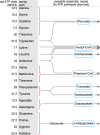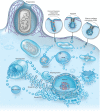The Physiology of Phagocytosis in the Context of Mitochondrial Origin
- PMID: 28615286
- PMCID: PMC5584316
- DOI: 10.1128/MMBR.00008-17
The Physiology of Phagocytosis in the Context of Mitochondrial Origin
Abstract
How mitochondria came to reside within the cytosol of their host has been debated for 50 years. Though current data indicate that the last eukaryote common ancestor possessed mitochondria and was a complex cell, whether mitochondria or complexity came first in eukaryotic evolution is still discussed. In autogenous models (complexity first), the origin of phagocytosis poses the limiting step at eukaryote origin, with mitochondria coming late as an undigested growth substrate. In symbiosis-based models (mitochondria first), the host was an archaeon, and the origin of mitochondria was the limiting step at eukaryote origin, with mitochondria providing bacterial genes, ATP synthesis on internalized bioenergetic membranes, and mitochondrion-derived vesicles as the seed of the eukaryote endomembrane system. Metagenomic studies are uncovering new host-related archaeal lineages that are reported as complex or phagocytosing, although images of such cells are lacking. Here we review the physiology and components of phagocytosis in eukaryotes, critically inspecting the concept of a phagotrophic host. From ATP supply and demand, a mitochondrion-lacking phagotrophic archaeal fermenter would have to ingest about 34 times its body weight in prokaryotic prey to obtain enough ATP to support one cell division. It would lack chemiosmotic ATP synthesis at the plasma membrane, because phagocytosis and chemiosmosis in the same membrane are incompatible. It would have lived from amino acid fermentations, because prokaryotes are mainly protein. Its ATP yield would have been impaired relative to typical archaeal amino acid fermentations, which involve chemiosmosis. In contrast, phagocytosis would have had great physiological benefit for a mitochondrion-bearing cell.
Keywords: endocytic pathway; eukaryogenesis; eukaryote evolution; metagenomics; mitochondria; phagocytosis.
Copyright © 2017 American Society for Microbiology.
Figures







References
-
- Jorgensen SL, Hannisdal B, Lanzén A, Baumberger T, Flesland K, Fonseca R, Øvreås L, Steen IH, Thorseth IH, Pedersen RB, Schleper C. 2012. Correlating microbial community profiles with geochemical data in highly stratified sediments from the Arctic Mid-Ocean Ridge. Proc Natl Acad Sci U S A 109:E2846–E2855. doi:10.1073/pnas.1207574109. - DOI - PMC - PubMed
-
- Zaremba-Niedzwiedzka K, Caceres EF, Saw JH, Bäckström D, Juzokaite L, Vancaester E, Seitz KW, Anantharaman K, Starnawski P, Kjeldsen KU, Stott MB, Nunoura T, Banfield JF, Schramm A, Baker BJ, Spang A, Ettema TJG. 2017. Asgard archaea illuminate the origin of eukaryotic cellular complexity. Nature 541:353–358. doi:10.1038/nature21031. - DOI - PubMed
Publication types
MeSH terms
Substances
LinkOut - more resources
Full Text Sources
Other Literature Sources

